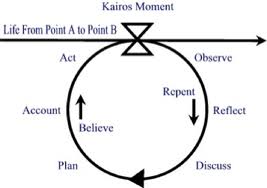Building a Discipling Culture: A Must Have Resource
0 comments
950 views

I've recently finished the book Building a Discipling Culture by Mike Breen and Steve Cockram and was so inspired by it I wanted to write a review. Then I checked my frequented blog reads and discovered Mark Howell had already done a fine job. With permission I've posted his review. GET THIS BOOK!
I’ve been looking forward to working my way through Building a Discipling Culture by Mike Breen and Steve Cockram. If you read my review of Launching Missional Communities or my 5 part interview with Mike Breen, you know that if anyone has a handle on making disciples in the post-Christian culture of the west, it is Breen and the folks from 3DM.
There are three parts to Building a Discpleship Culture. Part One provides a well written and convincing introduction to the essence of the dilemma–that “no one accidentally creates disciples. Discipleship is an intentional pursuit.” As a small group ministry veteran, I concur with one of their most important conclusions; that while most small groups are “excellent at creating warm and comfortable environments” they are not built to offer challenge.” And without environments that are both highly invitational and highly challenging…discipleship rarely if ever happens.
Part Two takes an extended look at a discipling language; essential when you understand that sociologists agree that “language creates culture.” Interestingly (and if you’ve followed much of the conversation here, you’d know why I love this), Breen has developed a way of talking about discipling using a language called LifeShapes. A series of 8 simple shapes (drawings) represent “a foundational teaching of Jesus or principle from His life.” The 8 basic shapes illustrate what we want people to know and do. Great stuff and very practical.
 The first shape provided offers a good example of the power of the idea. Illustrating the principle of continuous breakthrough, a simple circle is used. The chapter explains how kairos moments (“when the eternal God breaks into your circumstances with an event that gathers some loose ends of your life and knots them together in His hands”) can be used to teach a lifestyle of learning. We learn to use kairos moments to observe, reflect, and discuss followed by making a plan, forming accountability, and acting on the plan.
The first shape provided offers a good example of the power of the idea. Illustrating the principle of continuous breakthrough, a simple circle is used. The chapter explains how kairos moments (“when the eternal God breaks into your circumstances with an event that gathers some loose ends of your life and knots them together in His hands”) can be used to teach a lifestyle of learning. We learn to use kairos moments to observe, reflect, and discuss followed by making a plan, forming accountability, and acting on the plan.
Part Three provides an overview of how to use huddles to disciple people. Important to note that this part leads off with a note from the authors urging that you resist the temptation to start a huddle because you’ve read the material on how to lead one. Instead, they make the recommendation that you first be part of a huddle, so you can personally experience the practice. Making the case that you wouldn’t want to have a person performing open heart surgery because they’d read a book on it, it’s easy to see the wisdom of their caveat. Still, whether you follow this prescription or not, part three of Building a Discipleship Culture is fairly detailed. Covering not only key concepts and sample huddle outlines, there is also a launch guide that provides quite a bit of detail.
If, like many of us, you’re wrestling with Dallas Willard’s two questions every church must answer (i.e., “One, do we have a plan for making disciples? And two, does our plan work?”), Building a Discipling Culture is a must-have resource. I highly recommend it.
Small Groups
Small Groups
Connect to The Network and add your own question, blog, resource, or job.
Add Your Post
Let's Discuss
We love your comments! Thank you for helping us uphold the Community Guidelines to make this an encouraging and respectful community for everyone.